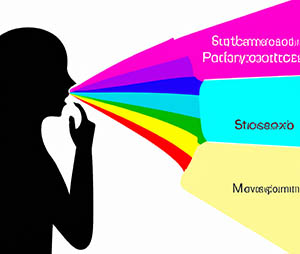Misophonia synesthesia
What is Misophonia Synesthesia?
While misophonia and synesthesia are distinct conditions, they share some similarities in terms of the sensory and emotional responses they produce. Both involve atypical connectivity in the brain, which may lead to unusual sensory experiences or perceptions.

In fact, some researchers have suggested that misophonia may be a type of synesthesia, in which certain sounds are involuntarily associated with negative emotional responses. According to this theory, misophonic individuals may be experiencing a type of "reverse synesthesia," in which the auditory stimuli normally associated with positive emotions (such as music or laughter) trigger negative emotions instead.
While this hypothesis is still being studied, there is some evidence to support the connection between misophonia and synesthesia. For example, a 2017 study found that individuals with misophonia had higher rates of synesthetic experiences, such as seeing colors when hearing certain sounds or experiencing tactile sensations when viewing specific shapes.
Additionally, a 2020 study found that individuals with misophonia showed atypical activation patterns in brain regions associated with both sensory processing and emotional regulation. This study suggested that misophonia may involve a hyper-sensitivity to certain stimuli, similar to the heightened sensory experiences of individuals with synesthesia.
Misophonia synesthesia is a neurological condition that affects a person's ability to tolerate certain sounds. The condition is characterized by an intense emotional and physical response to specific sounds, such as chewing, slurping, sniffling, snoring, typing, pen clicking, throat clearing, breathing, or tapping. Misophonia can be a distressing condition that significantly affects a person's quality of life, causing them to feel anxious, angry, and irritable, which can lead to physical symptoms such as increased heart rate, sweating, or muscle tension. Although misophonia is not officially recognized as a separate disorder in the Diagnostic and Statistical Manual of Mental Disorders (DSM), it is a real and distressing condition for those who experience it.
The term "synesthesia" refers to a condition in which sensory information from one sense triggers a response in another sense. In the case of misophonia, the trigger sounds are perceived as being unpleasant or even painful, leading to a strong emotional and physical reaction.
Causes of Misophonia Synesthesia
The exact cause of misophonia synesthesia is still unknown. However, researchers believe that the condition may be related to an overactive limbic system, which is responsible for processing emotions. People with misophonia may have an increased sensitivity to certain sounds due to a hyperactive emotional response to them.
Another possible cause of misophonia synesthesia is a malfunction in the way the brain processes sound. Some studies have suggested that the auditory cortex, which is responsible for processing sound, may be hyperactive in people with misophonia. This may cause sounds to be perceived as more intense and unpleasant, leading to a strong emotional and physical response.
Symptoms of Misophonia Synesthesia
The main symptom of misophonia synesthesia is an intense emotional and physical response to certain sounds. The response may include anxiety, anger, or irritation, which can be triggered by a variety of sounds, including eating, breathing, or tapping. The response can be so strong that it can significantly affect a person's quality of life, causing them to avoid certain situations or activities.
In addition to the emotional response, people with misophonia may also experience physical symptoms such as increased heart rate, sweating, or muscle tension. These symptoms may be similar to those experienced during a panic attack and can be distressing for the person affected.
Treatments for Misophonia Synesthesia
Currently, there is no known cure for misophonia synesthesia. However, there are several treatments available that can help manage the condition and reduce its impact on a person's life.
One common treatment for misophonia is cognitive-behavioral therapy (CBT). This type of therapy focuses on changing the way a person thinks about and reacts to their trigger sounds. Through CBT, a person can learn to identify and challenge negative thoughts and beliefs that may be contributing to their emotional and physical response to certain sounds.
Another treatment for misophonia is sound therapy. This involves listening to white noise or other calming sounds to help desensitize a person to their trigger sounds. Over time, exposure to these sounds can reduce the intensity of the emotional and physical response.
Finally, medication may be prescribed to help manage the symptoms of misophonia. Antidepressants and anti-anxiety medications can be used to reduce anxiety and irritability and help a person cope with their trigger sounds.